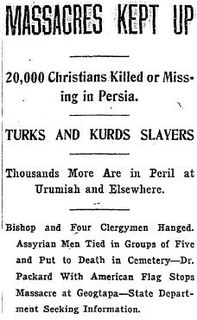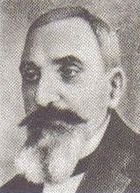
The Armenian Genocide, also known as the Armenian Holocaust, was the Ottoman government's systematic extermination of 1.5 million Armenians, mostly citizens within the Ottoman Empire. The starting date is conventionally held to be 24 April 1915, the day that Ottoman authorities rounded up, arrested, and deported from Constantinople to the region of Angora (Ankara), 235 to 270 Armenian intellectuals and community leaders, the majority of whom were eventually murdered. The genocide was carried out during and after World War I and implemented in two phases—the wholesale killing of the able-bodied male population through massacre and subjection of army conscripts to forced labour, followed by the deportation of women, children, the elderly, and the infirm on death marches leading to the Syrian Desert. Driven forward by military escorts, the deportees were deprived of food and water and subjected to periodic robbery, rape, and massacre. Other ethnic groups were similarly targeted for extermination in the Assyrian genocide and the Greek genocide, and their treatment is considered by some historians to be part of the same genocidal policy. Most Armenian diaspora communities around the world came into being as a direct result of the genocide.

The Assyrian or Syriac genocide refers to the mass slaughter of the Syriac Christian population of the Ottoman Empire and those in neighbouring Persia by Ottoman troops during the First World War, in conjunction with the Armenian and Greek genocides.
Armenian Americans are citizens or residents of the United States who have total or partial Armenian ancestry. They form the second largest community of the Armenian diaspora after Armenians in Russia. The first major wave of Armenian immigration to the United States took place in the late nineteenth and early twentieth centuries. Thousands of Armenians settled in the United States following the Hamidian massacres of the mid-1890s, the Adana Massacre of 1909, and the Armenian Genocide of 1915 in the Ottoman Empire. Since the 1950s many Armenians from the Middle East migrated to America as a result of political instability in the region. It accelerated in the late 1980s and has continued after the dissolution of the Soviet Union in 1991 due to socio-economic and political reasons.

The deportation of Armenian intellectuals, sometimes known as Red Sunday, was the first major event of the Armenian Genocide. Leaders of the Armenian community in the Ottoman capital of Constantinople, and later other locations, were arrested and moved to two holding centers near Ankara. The order to do so was given by Minister of the Interior Talaat Pasha on 24 April 1915. On that night, the first wave of 235 to 270 Armenian intellectuals of Constantinople were arrested. Eventually, the total number of arrests and deportations amounted to 2,345. With the adoption of the Tehcir Law on 29 May 1915, these detainees were later relocated within the Ottoman Empire; most of them were ultimately killed. A few, such as Vrtanes Papazian and Komitas, were saved through intervention.

Armenian Genocide denial is the act of denying the planned systematic genocide of 1.5 million Armenians during World War I, conducted by the Ottoman government. Turkey similarly denies the genocides perpetrated against indigenous Assyrians and Greeks during the same period. As form of denialism, it can be compared to similar negationist historical revisionisms such as Holocaust denial and Nanking Massacre denial.

The Armenian Genocide memorial complex is Armenia's official memorial dedicated to the victims of the Armenian Genocide, built in 1967 on the hill of Tsitsernakaberd in Yerevan. Every year on April 24—the Armenian Genocide Remembrance Day—thousands of Armenians gather at the memorial to commemorate the victims of the genocide. The people who gather in Tsiternakaberd lay fresh flowers out of respect for all the people who died in the Armenian genocide. Over the years, from around the world, a wide range of politicians, artists, musician, athletes, and religious figures have visited the memorial.
Armenians in France are French citizens of Armenian ancestry. The French Armenian community is, by far, the largest in the European Union and the third largest in the world.

Armenian Genocide recognition is the formal acceptance that the systematic massacres and forced deportation of Armenians committed by the Ottoman Empire from 1915 to 1923 constituted genocide. The consensus of historians and academic institutions on Holocaust and genocide studies recognize the Armenian Genocide. However, despite the recognition of the genocidal character of the massacre of Armenians in scholarship as well as in civil society, some governments have been reticent to officially acknowledge the killings as genocide because of political concerns about their relations with the Republic of Turkey, the successor state of the Ottoman Imperial authorities which perpetrated the genocide. The governments of Turkey and its close ally The Republic of Azerbaijan are the only ones that directly deny the historical factuality of the Armenian Genocide, and both are adamantly opposed to the recognition of the genocide by other nations, threatening economic and diplomatic consequences to recognizers.

Diran Kelekian was an Ottoman Armenian journalist and professor at the University of Istanbul. He was editor of two newspapers, Cihan and Sabah. He was murdered in the Armenian Genocide.
Diran Chrakian was an Armenian poet, writer, painter and teacher, and a victim of Armenian Genocide.
Armenian Canadians are Canadian citizens of Armenian national background or descent. The 2006 census determined that their number was 50,500 and the 2016 census determined that 35,790 had Armenian as their mother tongue. A large part of the Armenian diaspora in Canada came from nations in the Middle East and some from Europe. Canada has also seen increased immigration from Armenia, especially after the collapse of the Soviet Union.

Mary Louise Graffam was an American teacher, high school principal, Christian missionary, and an important witness to the Armenian Genocide. In 1915 she was deported and is considered a victim of the Armenian Genocide.
Tigran is an Armenian given name. The historical name is Tigranes, primarily kings of Armenia.
Levon or Lévon, is an Armenian given name equivalent to Leon.

Valerie Toranian is a French journalist and the editor-in-chief of the fashion magazine Elle in France. She is also the founder of Nouvelles d'Arménie, a French-Armenian journal. She is the head of the Elle Foundation in France and the general manager of the Revue des deux Mondes.
Levon Aghababyan was an Armenian mathematician, headmaster of high schools in Kütahya and Akşehir (1908–14), directed his own school in Kütahya for three years.










